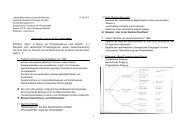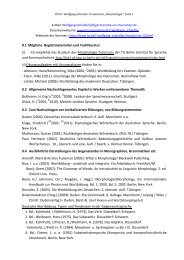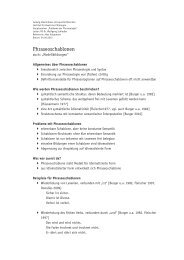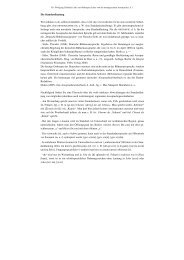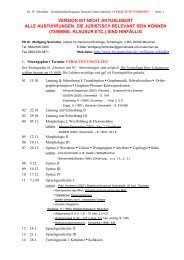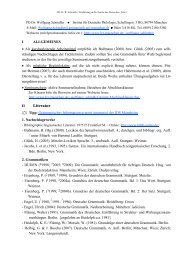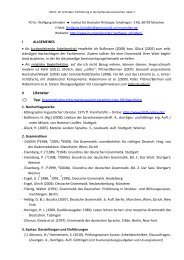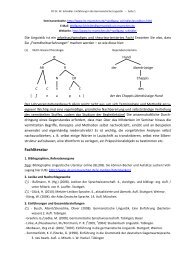Chapter 18 Lexical Functions: Description of Lexical Relations in a ...
Chapter 18 Lexical Functions: Description of Lexical Relations in a ...
Chapter 18 Lexical Functions: Description of Lexical Relations in a ...
Create successful ePaper yourself
Turn your PDF publications into a flip-book with our unique Google optimized e-Paper software.
Here are some examples <strong>of</strong> LFs.<br />
—<strong>Chapter</strong> <strong>18</strong>. <strong>Lexical</strong> <strong>Functions</strong>— 13<br />
(f) = (the one who/which undergoes L) [patient noun; a semantic derivation]<br />
S 2(shootV) = target S 2(serveV) = client<br />
S 2(hotel) = guest S 2(prison) = prisoner<br />
S 2(doctor) = patient S 2(hair-dresser) = customer<br />
(f) = (<strong>in</strong>tense(ly) L), (very L) [<strong>in</strong>tensifier; a collocate]<br />
Magn(shaveN) = clean, close, smooth Magn(naked) = stark<br />
Magn(easy) = as pie, as 1-2-3 Magn(sk<strong>in</strong>ny) = as a rake<br />
Magn(condemnV) = strongly Magn(relyV) = heavily<br />
(f) ≈ (do L), (perform L) [support, or light, verb; a collocate]<br />
Oper 1(cryN) = let out [ART ~] Oper 1 (figureN) = cut [ART ~]<br />
[He cut a f<strong>in</strong>e/miserable figure]<br />
Oper 1 (strikeN) = be [on ~] Oper 1 (visitN) = pay [ART ~]<br />
Oper 1 (tripN) = take [ART ~] Oper 1 (orderN) = give [ART ~]<br />
(f) = (realize L), (fulfill [a requirement <strong>of</strong>] L) [realization verb; a collocate]<br />
Real 2(testN) = withstand [ART ~]<br />
Real 2(jokeN) = get [ART ~]<br />
Real 2 (examN) = pass [ART ~]<br />
Real 2(m<strong>in</strong>eN) = hit, strike [ART ~]<br />
[Their car struck a land m<strong>in</strong>e]<br />
Real 2(ambushN) = fall, step, run, walk<br />
[<strong>in</strong>to (ART) ~]<br />
Real 2(challengeN) = meet [ART ~]<br />
[The expression <strong>in</strong> square brackets represents the Government Pattern [= GP] <strong>of</strong> the keyword <strong>of</strong> the LF; the<br />
symbol ART <strong>in</strong>dicates that an article or a grammatically equivalent determ<strong>in</strong>er should be used accord<strong>in</strong>g to<br />
grammatical rules; the tilde ~ stands for the keyword. For more about GPs <strong>of</strong> LFs, see below, 4.4, p. 00]<br />
The follow<strong>in</strong>g examples show how the mean<strong>in</strong>g (very) can be expressed <strong>in</strong> different langua-<br />
ges <strong>in</strong> order to modify the mean<strong>in</strong>g (th<strong>in</strong>/sk<strong>in</strong>ny); they demonstrate the l<strong>in</strong>guistic variability and<br />
wealth <strong>of</strong> LF expressions:<br />
Arabic [Standard]<br />
nāħif nāħāfa(t) lit. (sk<strong>in</strong>ny [with-]sk<strong>in</strong>n<strong>in</strong>ess)<br />
Z#adīd annāħāfa(t) lit. (strong [with-]the-sk<strong>in</strong>n<strong>in</strong>ess)<br />
ka/anna+hu Z#ild ?alā ?az`m lit. (as-if-he-were sk<strong>in</strong> on bones)


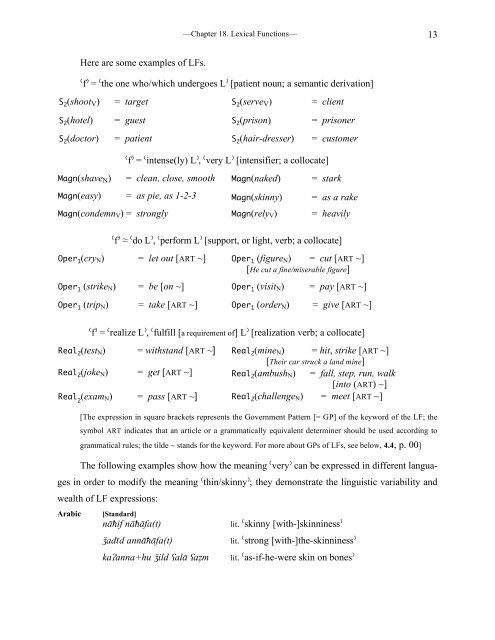
![E-Mail: Wolfgang.Schindler[ätt]germanistik.uni-muenchen.de Web ...](https://img.yumpu.com/51590147/1/184x260/e-mail-wolfgangschindlerattgermanistikuni-muenchende-web-.jpg?quality=85)
